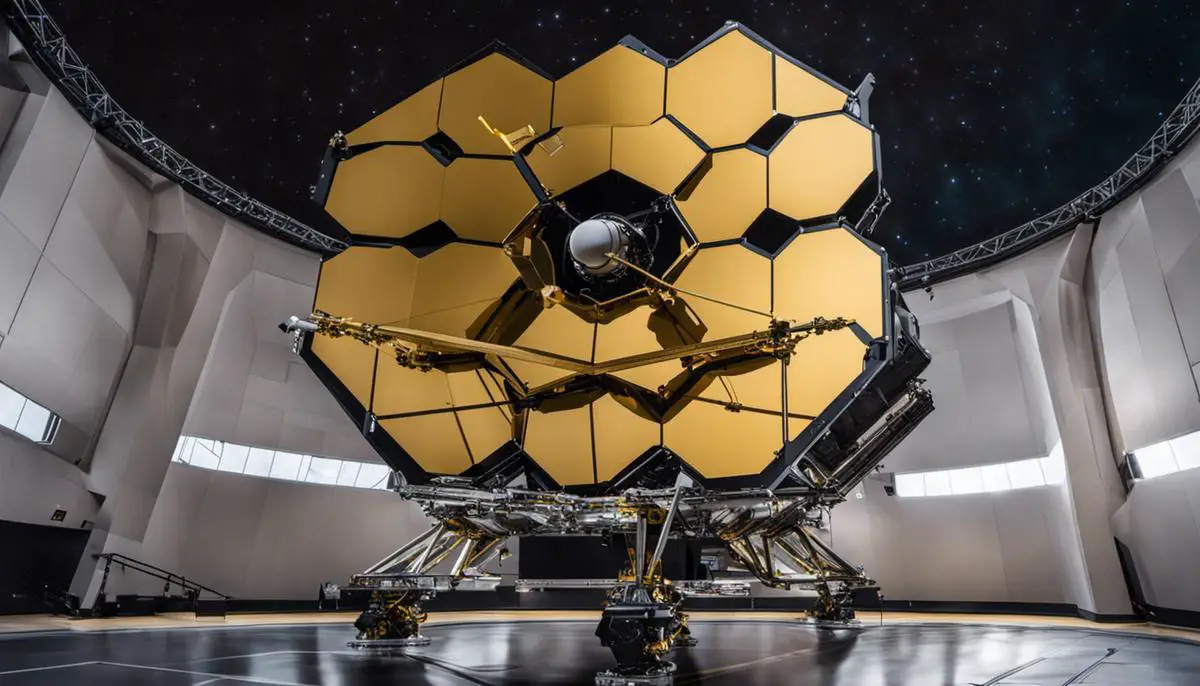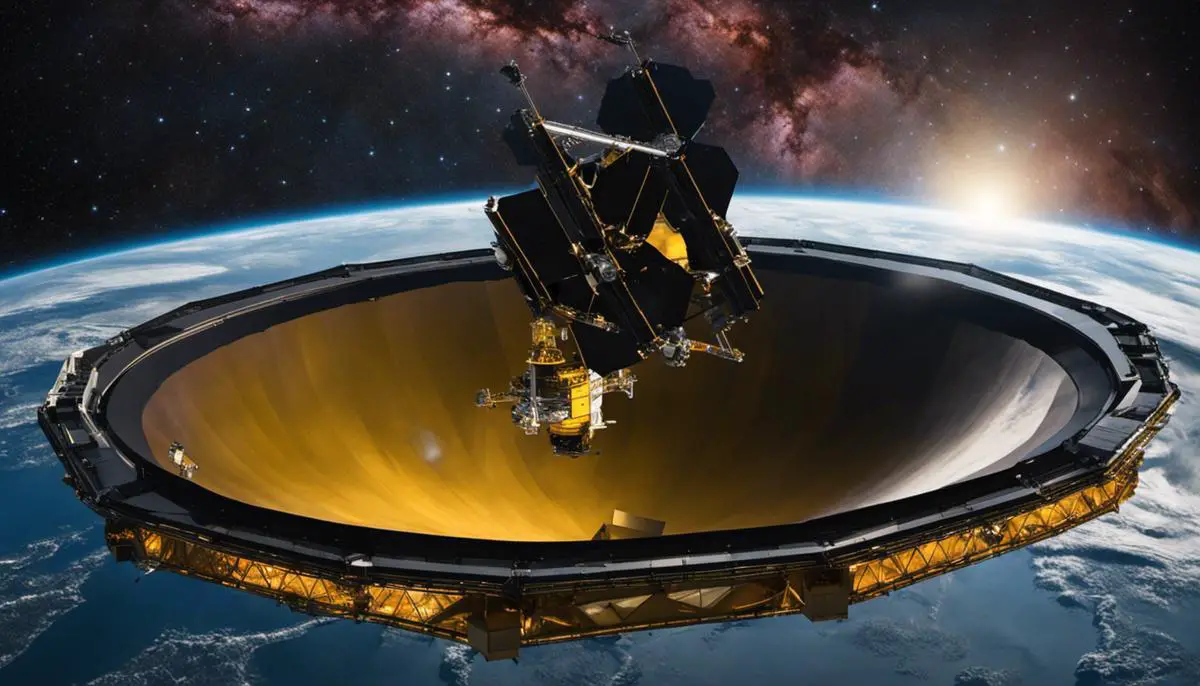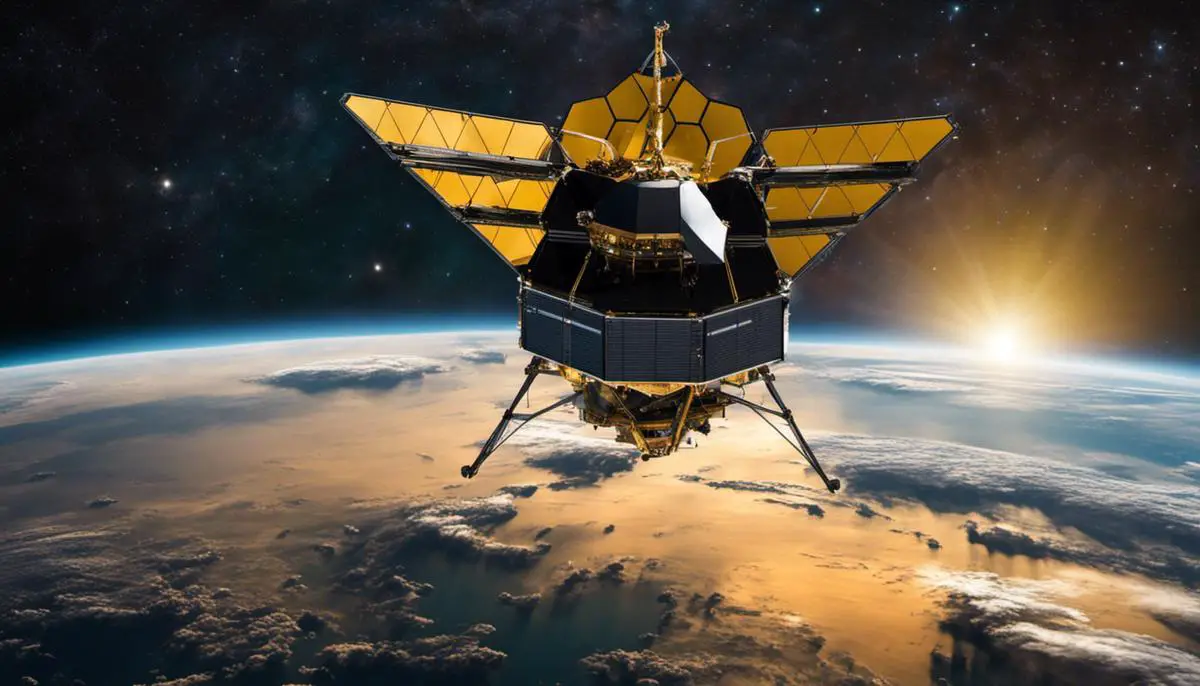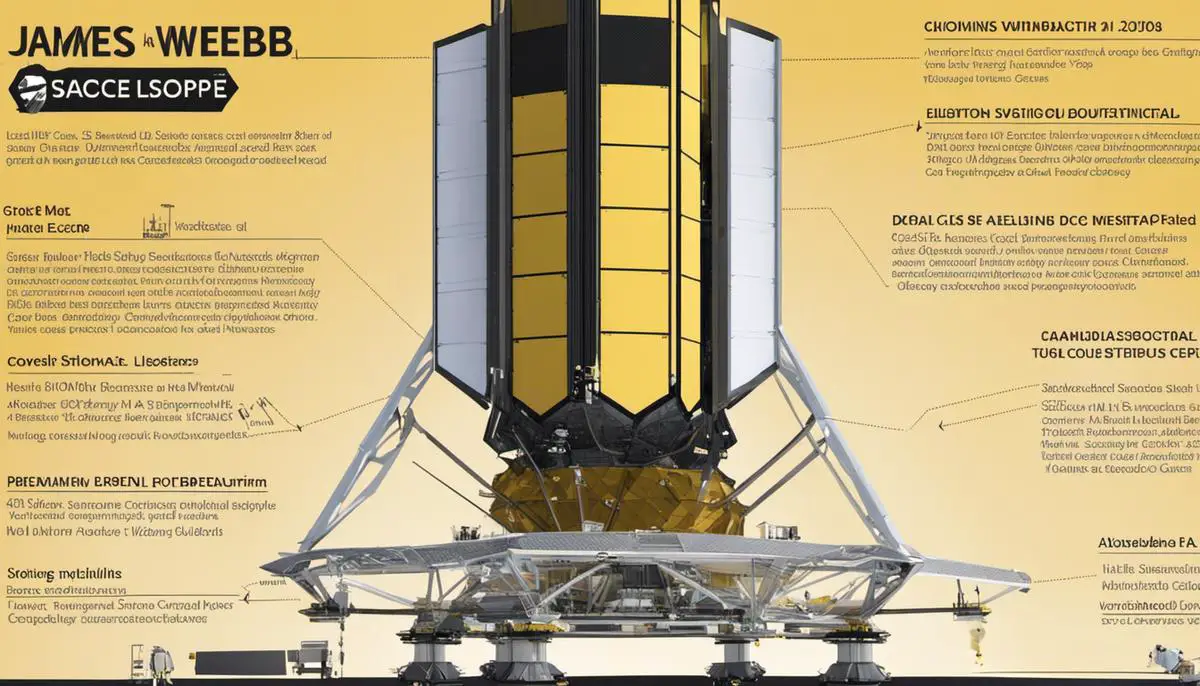It is remarkable to observe the astonishing advances of human innovation when we look to the skies. Our quest for understanding has led us to create machines capable of deciphering the cosmos, with the James Webb Space Telescope (JWST) being the epitome of our progress. This miraculous invention is more than just a telescope; it is a testament to our curiosity and the lengths we are prepared to go to satisfy it. Engineered with meticulous precision and cutting-edge technology, the JWST helps us unravel the enigmatic beauty of the universe. It is not just about viewing celestial bodies, but also about piecing together a puzzle millions of years in the making.
The James Webb Space Telescope: An Overview
The Significance of the James Webb Space Telescope
In the landscape of space exploratory tools, the James Webb Space Telescope (JWST) has speedily emerged as a revolutionary figure. As a joint venture between NASA, the European Space Agency (ESA), and the Canadian Space Agency (CSA), JWST’s design and capabilities place it leagues ahead of its predecessors in space exploration. Aimed at studying every phase in the history of our universe, from the first luminous glows after the Big Bang to the formation of solar systems capable of supporting life on planets like Earth, the James Webb Space Telescope is an imperative conduit in deepening our understanding of the universe.
Design and Construction of the James Webb Space Telescope
The engineering marvel that is JWST is demonstrable in its intricate design and meticulous construction. The telescope’s primary mirror – the largest ever put into space – spans 6.5 meters (21.3 feet) in diameter and is composed of 18 hexagonal segments of beryllium. These segments are coated with a microscopically thin layer of gold to optimize them for reflecting infrared light. The telescope also features a tennis-court-sized, five-layer sunshield designed to cool the telescope to temperatures below -220° Celsius. This extremely low temperature enables the telescope to pick up faint heat signals from distant galaxies and celestial bodies, which would otherwise be drowned out by the device’s own heat radiation.
Cutting-Edge Technology of the James Webb Space Telescope
The JWST flaunts unique, cutting-edge technology that sets it apart from prior space-exploration instruments. Unlike Hubble’s single monolithic primary mirror, JWST’s primary mirror is made up of 18 adjustable mirror segments. These allow for correction of possible errors or minute misalignments, thus enhancing image stability and clarity. Additionally, JWST operates primarily in the infrared range of the electromagnetic spectrum, with some capability in the visible range. With this capability, the telescope allows us to look further into the past of our universe, to see the very first generation of galaxies that formed after the Big Bang.
An Introduction to Understanding the Universe with the James Webb Space Telescope
The quest to comprehend our universe necessitates tools that can gaze deep into space, to the very brink of time’s inception. Among these tools, the James Webb Space Telescope (JWST) takes an eminent position. Recognized as the most potent space telescope ever constructed, the JWST possesses the capability to intercept light from the earliest galaxies and analyze their formation patterns. It also has the potential to scrutinize the atmospheres of planets outside our solar system for indications of life, thereby transforming our comprehension of alien worlds. Through its profound study of celestial entities, like dark matter, cosmic expansion, star creation, and the genesis of life, the JWST will illuminate previously unsolved cosmic mysteries and, in doing so, redefine our understanding of the universe.

Functionality and Purpose of the JWST
The Masterpiece of Modern Engineering: James Webb Space Telescope (JWST)
Designed with the intent of orchestrating groundbreaking observations of our universe, the James Webb Space Telescope (JWST) stands as a testament to modern engineering. Christened after James E. Webb, the second administrator of NASA, this comprehensive observatory is poised to become the successor to the legendary Hubble Space Telescope.
Functionality: A Infrared Powerhouse Witnessing the Birth of Stars and Galaxies
Unlike Hubble, which observes primarily in the visible and ultraviolet portions of the spectrum, the JWST is primarily an infrared telescope. It boasts an expansive 6.5-meter primary mirror (over twice the size of Hubble’s), giving it the power to collect far more light and detail of cosmic objects. By focusing in the infrared range of the light spectrum, the JWST can investigate astrophysical phenomena that are otherwise invisible to the human eye. It is through this manipulation of infrared that the JWST opens a window into the period of our universe’s history when the first galaxies were born.
Scientific Mission: Unlocking the Secrets of Dark Matter and Distant Galaxies
Part of the JWST’s mission is aimed at unveiling the mysteries surrounding dark matter – a type of matter that does not absorb, reflect, or emit light, making it extremely difficult to detect. However, by observing the way galaxies rotate and the formation of large-scale structures in the universe, scientists can deduce the presence and characteristics of dark matter. With the JWST, they hope to gather more data to support the theories surrounding this elusive component of our universe.
Moreover, the JWST is designed to look deeper into the universe, capturing the light from the very first galaxies. These galaxies are billions of light years away, meaning the light we can now observe left these galaxies when the universe was only a fraction of its current age. Studying these galaxies aids astrophysicists in understanding how these cosmic structures evolve over time.
Exoplanet Study: Inspecting the Atmospheres of Extrasolar Planets
The JWST’s spectrographs are capable of dissecting the light from stars as it passes through the atmospheres of exoplanets – planets orbiting stars outside our solar system. This light provides scientists with a unique means of analyzing the composition of these atmospheres, offering clues about the potential for life beyond Earth.
Purpose: Aiding in Understanding the Evolution of the Universe
Since the JWST can observe infrared light emitted by celestial bodies, it can provide a glimpse into the earliest stages of the universe and how it has evolved over billions of years. The JWST is expected to yield valuable data that can test and refine our understanding of the universe’s history, from the Big Bang to the present.
Unfolding Mysteries with the JWST
The James Webb Space Telescope (JWST) stands as more than just a space telescope; it embodies a critical instrument for deciphering the cosmos’s clandestine tales. With its unique capability to capture infrared observations, it harbors the potential to yield unparalleled insights into the genesis of galaxies, the enigmas of dark matter, and the atmospheric makeup of extraterrestrial planets. These aspects collectively augment our comprehensive understanding of the evolution of the universe to its current state.
-WZc.jpeg)
Notable Achievements and Discoveries by the JWST
Launching the JWST: A Pioneering Feat
Multi-agency collaboration between NASA, ESA (European Space Agency), and CSA (Canadian Space Agency) fostered the successful launch of the James Webb Space Telescope (JWST) on December 25, 2021. This launch didn’t just represent a significant milestone for the project team but set new precedents in the field of astrophysics and humanity’s relentless pursuit to comprehend the cosmos. The launch and deployment of the JWST underscored the power of human innovation, years of rigorous preparation, and the spirit of international teamwork.The Webb’s Remarkable Capabilities
The JWST is the most powerful space telescope ever built, surpassing its predecessor, the Hubble Space Telescope, in numerous ways. With sensitivity to infrared light, the Webb can see through dust clouds that typically obscure stars and galaxies. This allows scientists to observe celestial events in unprecedented detail. The spectrograph instruments on the JWST enable researchers to determine the makeup of distant planets’ atmospheres or tell us about the composition of the early universe. Webb’s sunshield, which is about the size of a tennis court, helps to keep its mirrors and scientific instruments cool by blocking out heat from the Sun, Earth, and Moon, thereby enabling the infrared technology to function optimally.The Observation of Exoplanets and Potential for Discovering Extraterrestrial Life
One of the JWST’s significant objectives is the observation of exoplanets, i.e., planets beyond our solar system. This has far-reaching implications for the search for life outside Earth. JWST’s powerful infrared sensors will allow scientists to analyze the atmosphere of these distant worlds for signs of life, such as specific gases like methane, oxygen, and water vapor. With over 4,000 exoplanets currently discovered, the Webb telescope could uncover earth-like conditions on these distant worlds, heralding a new era in our understanding of life’s existence beyond Earth.Unfolding the mysteries of the Early Universe
Another key goal of the JWST is to gaze further into the cosmos than ever before, scanning the universe’s early days. Astronomers hope to capture light from the first formation of galaxies, about 13.5 billion years ago, providing new insights into the universe’s early stages. By observing these first stars and galaxies and their nature, JWST will help us understand the evolution of galaxies and the universe as a whole.Unanswered Questions in Modern Astronomy
Many mysteries that persist in modern astronomy, such as dark matter and dark energy – together constituting about 95% of the universe – are hoped to be addressed by the JWST. By observing galaxies of varying ages, scientists hope to explore dark matter’s role in the formation and growth of galaxies. The observations of type Ia supernovae, a type of exploding star, could provide insights into the nature of dark energy, which is understood to drive the universe’s accelerated expansion.In the nascent stage of the Webb Telescope’s mission, which is expected to last between 10 to 20 years, we stand at a critical juncture in our understanding of the universe. The telescope doesn’t just provide us with a fresh perspective on our cosmic surroundings, it opens a gateway to the potential for exciting new discoveries that we can only imagine.

The Future Role of the JWST in Space Exploration
The Role of JWST in the Future of Space Exploration
Set to serve as the successor to the Hubble Space Telescope, the James Webb Space Telescope (JWST) is envisioned to be a game-changer in the field of astronomy. Hubble has been pivotal in numerous groundbreaking cosmic revelations over the past thirty years. The JWST, designed with a mirror nearly 2.7 times as large as Hubble’s, will boast a collecting area seven times more extensive. This unprecedented scope of observation will allow JWST to scrutinize vaster portions of the universe, as well as detect dimmer celestial bodies, setting the stage for a new chapter in space exploration.
JWST’s Revolutionary Design and Instrumentation
The JWST’s innovative design is centered around its primary mirror, which has a diameter of 6.5 meters (compared to Hubble’s 2.4 meters). This larger mirror enables the JWST to collect more light and thus observe fainter and more distant objects. Beyond just size, the JWST has been designed for optimized performance in the infrared part of the electromagnetic spectrum. Peering deep into the universe in infrared light will allow astronomers to study phenomena largely inaccessible to Hubble, such as the formation of the first galaxies.
Unraveling Cosmic Mysteries with JWST
One primary objective of the JWST is to probe the enigmatic dark matter and dark energy phenomena that appear to dominate the universe. To this end, the telescope will survey large portions of the universe to study the distribution of galaxies and the large-scale structure of the cosmos. Additionally, JWST will make crucial observations in the study of exoplanets, potentially identifying signs of life. It will be critical in validating and following up on discoveries made by current and future space and ground-based surveys.
JWST’s Role in Fundamental Science
In terms of fundamental science, the JWST is expected to make significant strides. Its ability to observe the universe in the infrared spectrum opens a new window into astrophysics, from studying the formation of stars and galaxies to the origins of life itself. The telescope is slated to operate for a minimum of five years, with a goal of over a decade. Within this timeframe, the data JWST will generate could resolve some of the mystifying questions in astrophysics, and more notably, raise new ones, setting the agenda for astronomy research for decades to come.
JWST’s Legacy in Space Exploration
The JWST incorporates lessons learned from previous telescopes, aiming to shine a new light on the universe’s mysteries. Its on-orbit performance should indeed serve as an operational benchmark for future large space observatories. The construction and launch of the James Webb Space Telescope underscore the maturation of space science and technology. The project showcases how international collaboration can overcome intricate engineering challenges in the world of space exploration. In essence, JWST’s future legacy will not just be revolutionary research findings and an improved understanding of our universe, but also advancements in space science technology and strengthened international collaboration.

As we stand on the brink of countless revelations, the James Webb Space Telescope symbolizes a beacon of human achievement illuminating the vast expanse of our universe. Its valuable contributions help propel our understanding of the cosmos and our place in it, by challenging our assumptions and reshaping our notions of what is possible. In peering back to the origins of time, the JWST not only provides a window into the evolution of our universe, but also reflects the tremendous capability of human ingenuity and innovation. This telescope provides a new lens through which to understand our existence, reminding us that the universe’s mysteries are vast, but not insurmountable, and that our quest for knowledge is as boundless as space itself.
![]()
